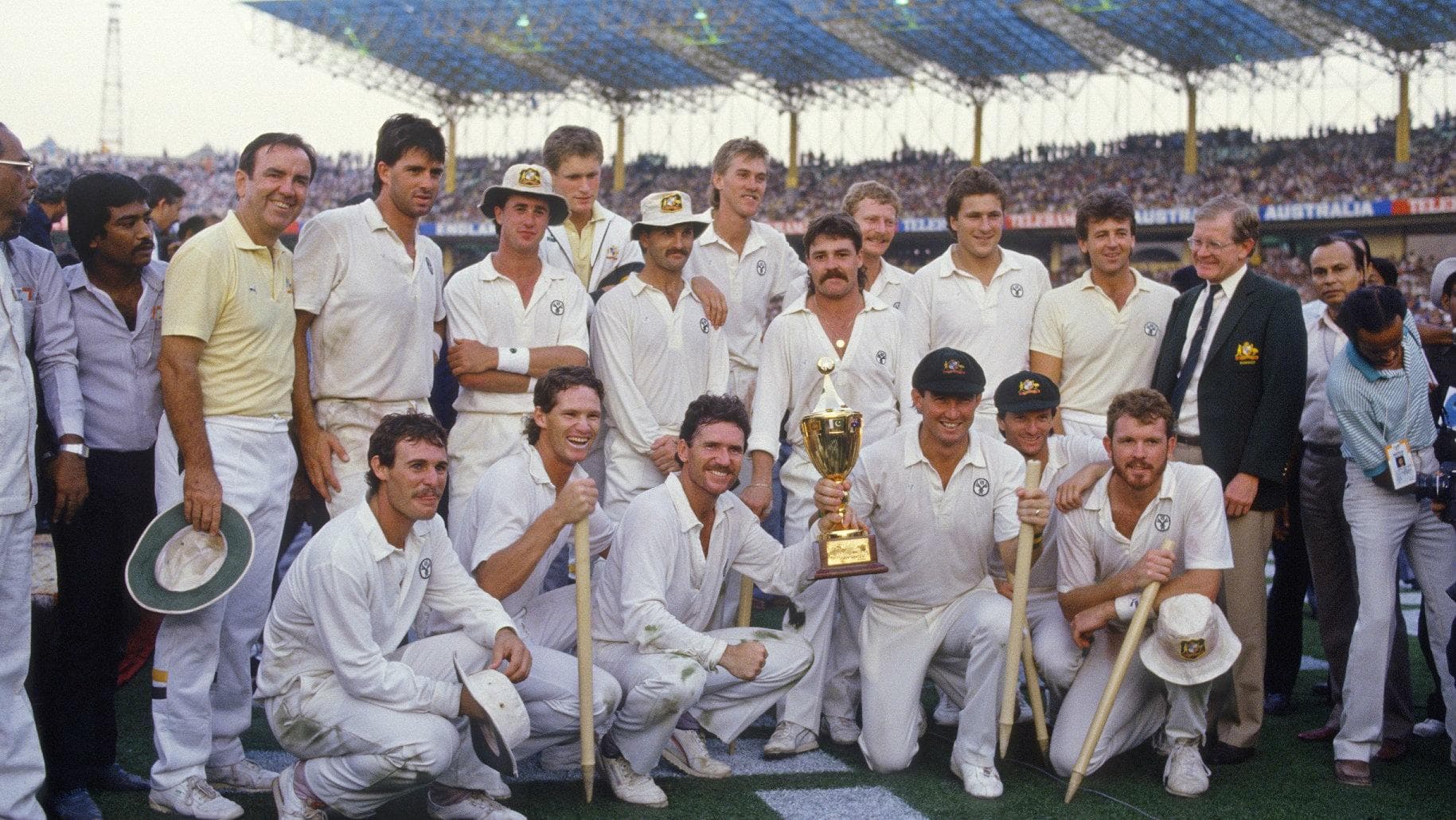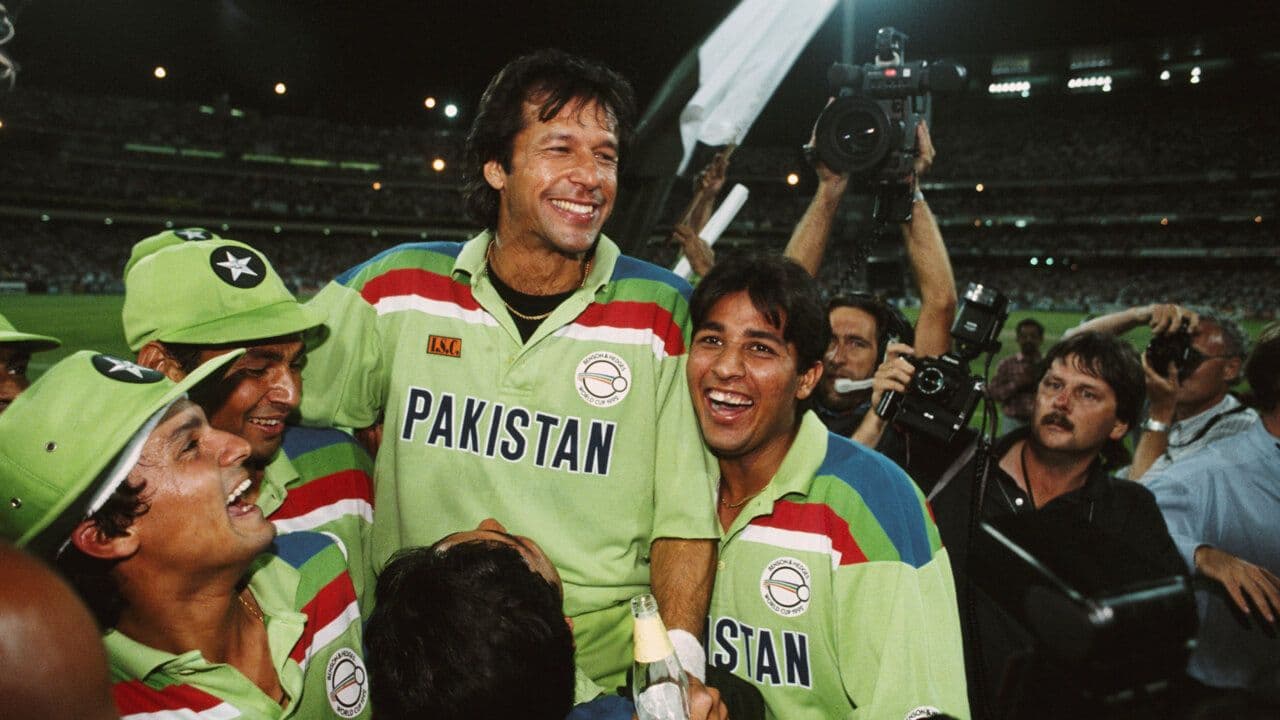Cricket
Australia vs England 1987 World Cup Final
The final of the 1987 Cricket World Cup was held at Eden Gardens in Kolkata on November 8, 1987. Australia beat England by 7 runs.

A Thrilling Final
Australia vs England 1987 World Cup Final – When Australia’s dominance in the World Cups began
The 1987 Cricket World Cup, officially known as the Reliance World Cup, was the fourth edition of the tournament. Hosted by India and Pakistan from October 8 to November 8, the 1987 World Cup saw one major change - the reduction of the number of overs per side from 60 to 50. This alteration became a standard for ODI cricket moving forward. The final match between Australia and England at the iconic Eden Gardens in Kolkata went down to the wire, before Australia claimed the trophy.
Road to the Australia vs England 1987 World Cup Final
AUSTRALIA JOURNEY IN 1987 WORLD CUP
| DATE | VENUE | OPPONENT | RESULT | MARGIN |
|---|---|---|---|---|
| 9 Oct | Chennai | India | Won | by 1 run |
| 13 Oct | Chennai | Zimbabwe | Won | by 96 runs |
| 18 Oct | Indore | New Zealand | Won | by 3 runs |
| 22 Oct | Delhi | India | Lost | by 56 runs |
| 27 Oct | Chandigarth | New Zealand | Won | by 27 runs |
| 30 Oct | Cuttack | Zimbabwe | Won | by 70 runs |
| 4 Nov | Lahore | Pakistan | Won | by 18 runs |
| 8 Nov | Kolkata | England | Won | by 7 runs |
The 1987 World Cup featured a round-robin format with a total of eight participating teams. These teams included the hosts, India and Pakistan, along with Australia, England, West Indies, New Zealand, Sri Lanka, and Zimbabwe.
Eventual finalists Australia and England navigated their way through the group stage successfully, finishing second in their respective groups. Australia, led by Allan Border, started their campaign with a one-run win over India, following which they went on to defeat Zimbabwe and New Zealand before losing to India. They won their next two games – against New Zealand and Zimbabwe – to make it to the semi-final.
In the semi-final against Pakistan at the Gaddafi Stadium in Lahore, crucial knocks from David Boon (65) and Mike Veletta (48) propelled Australia to a total of 267 for 8, which they defended on the back of a five-wicket haul by Craig McDermott.
England, on the other hand, defeated West Indies by two wickets in their opening game, before losing to Pakistan, winning against Sri Lanka, losing to Pakistan again, and defeating West Indies and Sri Lanka. In the semi-final, they defeated India by 35 runs at Mumbai’s Wankhede Stadium. A century from Graham Gooch and a half century from skipper Mike Gatting helped England to a total of 254, after which they bowled out India for 219 as Eddie Hemmings and Neil Foster picked up seven wickets combined.
Australia vs England 1987 World Cup Final – an Ashes-like rivalry
AUSTRALIA VS ENGLAND
1987 WORLD CUP FINAL, MATCH SUMMARY
| AUSTRALIA | 253-5 | (50 OV) | ||
| DAVID BOON | 75 | 125 | EDDIE HEMMINGS | 2-48 |
| MIKE VELETTA | 45 | 31 | NEIL FOSTER | 1-38 |
| DEAN JONES | 33 | 57 | GRAHAM GOOCH | 1-42 |
| ENGLAND | 246-8 | (50 OV) | ||
| BILL ATHEY | 58 | 103 | STEVE WAUGH | 2-37 |
| ALLAN LAMB | 45 | 55 | ALLAN BORDER | 2-38 |
| MIKE GATTING (C) | 41 | 45 | SIMON O'DONNELL | 1-35 |
AUSTRALIA WON BY 7 RUNS
The final of the 1987 Cricket World Cup was held at Eden Gardens in Kolkata on November 8, 1987. This final marked the second appearance in a World Cup final for both Australia and England. Australia had previously reached the final in the inaugural edition in 1975 but were defeated by West Indies. England had also faced West Indies in the final in 1979 but had come up short. A majority of the 90,000-odd spectators at the Eden Gardens were supporting Australia, because England had beaten India in the semi-final, and Australia had beaten Pakistan.
Australia won the toss and elected to bat first. The final began with Australia's openers, David Boon and Geoff Marsh, putting on a steady partnership of 75 runs for the first wicket. They laid the groundwork for a competitive total, with Boon eventually falling for 75 runs. The middle-order batsmen, Dean Jones and Allan Border, continued the momentum. Jones played a crucial role, scoring a valuable 33 runs. Skipper Border also contributed with a significant 31 runs.
However, the star of Australia's lower middle order was Mike Veletta, who scored an unbeaten 31-ball 45 to guide Australia to a total of 253/5 in their allotted 50 overs. Veletta's quickfire knock added 65 runs from the final six overs of Australia's innings. Neil Foster, who gave away only 36 runs in his 10 overs while also picking a wicket, was England’s most economical bowler. The other three wickets were taken by Eddie Hemmings (2) and Graham Gooch (1).
England's chase got off to a rocky start as they lost early wickets, before their middle-order, including Bill Athey (58), captain Gatting (41) and Allam Lamb (48) attempted to steady the ship.
The England bowlers were struggling to secure wickets, leaving Australia in a favourable position at 135 - 2. It was at this point when skipper Border, a part-time bowler, decided to assume control of the situation.
The turning point of the match came in the 32nd over when Gatting, who was batting on 41 off 45, attempted to reverse sweep a delivery from Border and the ball was caught by wicketkeeper Greg Dyer. The notorious reverse sweep by Gatting is remembered as one of the biggest brain fade moments in cricket history.
Gatting's dismissal left England reeling, and they struggled to recover from the setback. Australia's collective economical bowling spell, led by Border (2/38) and Steve Waugh (2/37), played a crucial role in defending the target. England, who needed 17 runs off the final over, finished on 220 for 7, losing the final by just seven runs.
Australia's victory marked a historic moment, with Border becoming the first captain to lift the Cricket World Cup trophy for Australia. Border was eventually followed by Steve Waugh (1999), Ricky Ponting (2003 and 2007) and Michael Clarke (2015). While Australia have won the trophy five times, no other team has won it more than twice.
“There’s no doubt that 1987 was the catalyst for change for Australian cricket. Heading into the tournament, we were actually an unfancied side, so we kind of slipped under the radar a little bit. But winning our first game against hosts India gave us real momentum. We hadn’t had a lot of success in the years before and then all of a sudden we won the World Cup and it was a real surprise,” Border told ICC. “There was a definite reemergence of Australian cricket as a premier nation after that - it all started to blossom from there,” he added.
Top performers at the 1987 World Cup
Graham Gooch was the top run-scorer at the 1987 World Cup. He scored 471 runs in eight innings at an average of 58.87. David Boon was the second highest run-scorer, with 447 runs at an average of 56.87. Among the bowlers, Craig McDermott was the highest wicket-taker, with 18 wickets in eight innings, followed by Imran Khan, who took 17 wickets in six innings.
India’s performance at the 1987 World Cup
India's performance at the 1987 World Cup was largely impressive. Led by Kapil Dev, India played a total of six matches in the group stage, winning five and losing one. However, in the semi-final, they lost to England. Sunil Gavaskar was India’s top run-scorer, finishing with 300 runs in seven innings at an average of 50. Navjot Singh Sidhu also impressed with 276 runs from five innings at an average of 55.20. In the bowling department, Maninder Singh picked up 14 wickets, which also tied him for the tournament’s third-highest wicket-taker.
Recommended Articles

Umaima Saeed is a professional sports writer whose articles have been featured in several leading websites. She writes long-form content on sports, particularly cricket. She has a penchant for telling human-interest stories. Umaima has contributed articles on cricket to more than a dozen publications, both in print and online.


